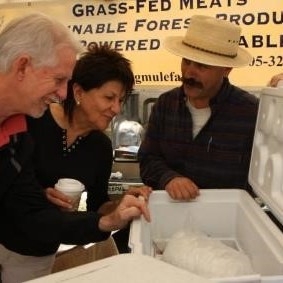
One of the most important economic resources is Sample Costs for Beef Cattle Finished on Grass (Forero et al, 2017). As the authors suggest, "Changing the business structure of the ranch from selling live animals to merchandising meat requires a new set of skills and knowledge." Ranchers who want to sell directly need to like interacting with the public and have a firm grasp on food safety, meat quality, and marketing regulations (for more on this, see Selling Meat and Meat Products).
According to the US Department of Agriculture's Agricultural Marketing Resource Center, value added products are defined as follows:
- "A change in the physical state or form of the product (such as milling wheat into flour or making strawberries into jam).
- "The production of a product in such a manner that enhances its value, as demonstrated through a business plan (such as organically produced products).
- "The physical segregation of an agricultural commodity or product in a manner that results in the enhancement of the value of that commodity or product (such as an identity preserved marketing system)
"As a result of the change in physical state or the manner in which the agricultural commodity or product is produced and segregated, the customer base for the commodity or product is expanded and a greater portion of revenue derived from the marketing, processing or physical segregation is made available to the producer of the commodity or product."
By definition, then, selling meat is selling a value added product - or is it? How do we know whether we're keeping a greater portion of the revenue if we're selling meat instead of selling a live animal?
The UC Davis cost study helps answer this question. It analyzes the purchase of 20, 800-pound heifers that will be finished on grass at a weight of 1100 pounds. The heifers will be grazed on leased irrigated pasture for a six-month grazing season at $30/AUM.
If you're considering selling meat (and even if you're already doing it), you might say, "but I already own the cattle - I wouldn't go out and buy heifers when I can simply finish my own! And I already have enough irrigated pasture, too - why would I rent it?"
This is a critical point in terms of analyzing a value-added business! In order to understand whether selling meat is actually adding value, the meat business has to buy the live animal (at least on paper) from the ranching business. If the ranch typically sells 800 pound heifers, the grass fed business has to rent pasture to finish these animals. In other words, the only way we can determine whether the extra costs associated with finishing and processing animals and then selling meat adds value is analyze the meat business as a stand-alone enterprise.
The cost study offers two sample economic analyses (one for selling carcass beef, and one for selling at farmers markets). I find the discussion extremely useful for thinking about the categories of additional expenses I incurred as a direct-market rancher. One important factor that I added in my own analysis, however, was the value of my time. Perhaps a typical summer week from 2012 will help illustrate this point.
During the summer of 2012, we marketed grassfed beef and lamb. I attended the Roseville Farmers Market each Tuesday, the Tahoe City and Truckee Evening Farmers Markets each Thursday, and the Auburn Farmers Market each Saturday. With this many markets each week, my sales volume was strong! However, from the time I left home in the morning to the time I'd put everything away after each market, this schedule took about 30 hours of my time (and over 200 miles of driving) each week. I did have help with some markets, but I always found that my customers would rather buy from me than from an employee (my best employees averaged about 60% of my typical sales). Alternatively, I could hire somebody to do all of the things that needed to be done at the ranch (irrigating, moving livestock, etc.). I also needed to handle scheduling with our meat processor; sort, load, and deliver live animals; pick up, store and inventory packages of meat. In other words, selling meat instead of live animals took much more of my time.
When we're selling meat, we can increase total revenue two ways: by selling more meat or by raising our prices. We found that we could get a premium for our grassfed lamb and beef, but that there was a limit to this premium. Most folks balk at paying more than $100 for a leg of lamb. While we could keep more of the consumer's meat-buying dollar in our own pocket, there was a limit to how much more most folks would spend.
Based on these experiences, I've taken the budget used in the cost study and added in marketing labor. I've also added in a line for an owner draw. After all, most of us aren't in business simply to pay our expenses - we need to pay ourselves, too! And we need to have a firm grasp on the value of our stories - how we raise our livestock is important; so is the quality of our product. That said, we found we needed to sell the entire animal (steaks as well as chucks) to be profitable.
Finally, there is a time element to all of this. When we take lambs to the auction or sell them to a processor, we have a check within a week's time. When I was selling meat, the cash flowed in more slowly. The time value of money, and the timing of cash inflows and outflows, are a consideration for any value added business, as well.
If you're thinking about marketing meat, or if you'd like to analyze your existing business, contact me at dmacon@ucanr.edu or (530) 889-7385 - I'd be happy to walk you through this analysis!